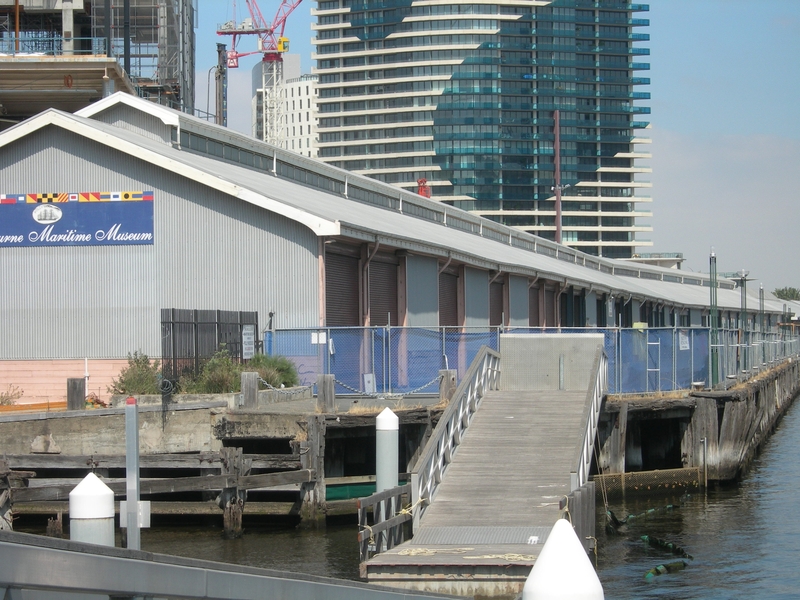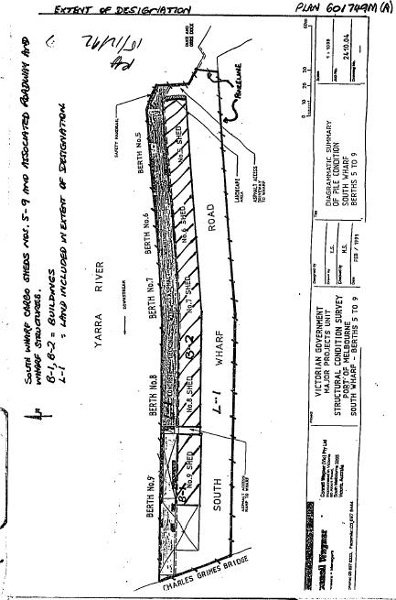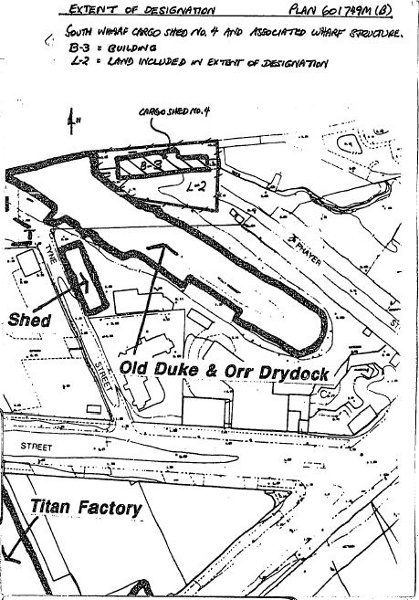CARGO SHEDS 4, 5, 6, 7, 8, 9
4-9 SOUTH WHARF ROAD SOUTH WHARF, MELBOURNE CITY
-
Add to tour
You must log in to do that.
-
Share
-
Shortlist place
You must log in to do that.
- Download report





Statement of Significance
1. The Cargo Sheds No. 4 and No. 5-9 South Wharf represent the last (in situ) remaining link with the cargo and berthing facilities of the nineteenth century river port of Melbourne, originally extending to Queen's Bridge, and is now the most eastern part of the port of Melbourne.
2. The Sheds, and associated wharfing, illustrate the small scale methods of cargo-handling direct from ship to wharf, in the era of trans-shipment and before the introduction of roll-on roll-off and container shipment. They have been in use for cargo-handling for over 60 years.
3. They also represent an important transitional link between the period of smaller shallow draught trading vessels and the age of larger vessels involving greater draughts, tonnage and length.
4. Cargo Shed No.9 Wharf, built in 1884, is the oldest cargo shed in situ along the river within the Port of Melbourne. Whilst its fabric has been partially destroyed by fire, the remaining shed provides sufficient evidence to illustrate the style of construction including the unusual truss design, alignment with the river, and association with the once thriving maritime industry within close proximity of the city of Melbourne. It is a unique survivor of a once-common building practice in the transport industry.
5. Cargo Sheds No.4 and Nos 5-8 South Wharf between 1929-31 reflect the construction principles of the early twentieth centuries including roller shutter doors at regular intervals rather than sliding doors, flexible open floor plan enabling berths to be allocated as required, and ridge lantern lighting for security and lighting.
6. The access roads to sheds number 5-9 (south wharf road) displays evidence of bluestone cobbles, and contains some of the earliest macadamised roadway within the port of Melbourne.
7. The sheds and wharves are also closely associated with the heart of Melbourne's ship building and marine engineering industry, carried out on the south bank of the river from the 1850s. As the focal point for Melbourne's commercial shipping trade, the Yarra River in the vicinity of Spencer Street Bridge was an important location for the repair, maintenance and construction of cargo vessels. It is significant that this area survives in close proximity to the commercial centre of the city of Melbourne.
The historical importance of the sheds and wharves is therefore enhanced by their location within an area that still retains its nineteenth century maritime character. The sheds themselves also make a significant contribution to the maritime precinct. Other elements include the Robur Tea House and Buchanan and Brock, engineering workshop, the Duke and Orr Dock, former Titan Wire Products factory, the amalgamated marine engineers building and the "Polly Woodside".
-
-
CARGO SHEDS 4, 5, 6, 7, 8, 9 - Permit Exemptions
General Exemptions:General exemptions apply to all places and objects included in the Victorian Heritage Register (VHR). General exemptions have been designed to allow everyday activities, maintenance and changes to your property, which don’t harm its cultural heritage significance, to proceed without the need to obtain approvals under the Heritage Act 2017.Places of worship: In some circumstances, you can alter a place of worship to accommodate religious practices without a permit, but you must notify the Executive Director of Heritage Victoria before you start the works or activities at least 20 business days before the works or activities are to commence.Subdivision/consolidation: Permit exemptions exist for some subdivisions and consolidations. If the subdivision or consolidation is in accordance with a planning permit granted under Part 4 of the Planning and Environment Act 1987 and the application for the planning permit was referred to the Executive Director of Heritage Victoria as a determining referral authority, a permit is not required.Specific exemptions may also apply to your registered place or object. If applicable, these are listed below. Specific exemptions are tailored to the conservation and management needs of an individual registered place or object and set out works and activities that are exempt from the requirements of a permit. Specific exemptions prevail if they conflict with general exemptions. Find out more about heritage permit exemptions here.Specific Exemptions:Location: Interior of Cargo Sheds 4, 5, 6, 7, 8 and 9 providing the works do not have any impact on the external envelope of the buildings or the structural integrity of the buildings and do not cause damage to or remove any original building fabric. The original store and office in Shed 4, original offices retained in Sheds 5 - 8, and the cargo cage retained in Shed 5 are not included as part of this exemption.
. Painting of the interior of all Sheds in any colour.
. Laying of flexible floor covering including carpet, carpet tiles and vinyl which does not damage the existing flooring (timber or concrete) or have an associated impact on the heritage structure.
. Rewiring of all fittings, installation of new general power outlets (GPO's), lights etc on the interior, installation of data and telephone cabling.
. Refurbishment of existing non-original kitchens, toilets, wash up areas, offices, service rooms, including joinery, wall tiling, fixtures and floor covering.
. Refurbishment of existing mechanical services.
. Installation of furnishings, curtains and the like.
. Installation of wall hooks and the like.
Location : Landscaping, not including shade structures.
Replacement of external furniture.CONDITIONS:
1. Exempt classes of works or activities are to be planned and carried out in a manner which prevents damage to the registered place / object. However, if other previously hidden original or inaccessible details of the object or place are uncovered, any works that may affect such items shall immediately cease. The Executive Director shall be notified of the details immediately to enable Heritage Victoria representatives to inspect and record the items, and for discussion to take place on the possible retention of the items, or the issue of a modified approval.
2. If there is a Conservation Policy and Plan approved by the Heritage Council or Executive Director, all works and activities shall be carried out in accordance with that Policy and Plan.
3. Nothing in this Declaration prevents the Executive Director from amending or rescinding all or any of the permit exempt alterations provided work has not commenced on the alteration.
THE ATTENTION OF THE OWNER AND/OR APPLICANT IS DRAWN TO THE NEED TO OBTAIN ALL
OTHER RELEVANT PERMITS PRIOR TO THE COMMENCEMENT OF WORKS.
CARGO SHEDS 4, 5, 6, 7, 8, 9 - Permit Exemption Policy
Pursuant to Section 66(1) of the Heritage Act (1995) and in respect to the above-registered place / object, the Executive Director hereby DECLARES EXEMPT THE OWNERS NEED TO OBTAIN A PERMIT TO CARRY OUT ANY OF THE FOLLOWING CLASSES OF WORKS OR ACTIVITIES, SUBJECT TO ANY CONDITIONS PRESCRIBED HEREUNDER:
-
-
-
-
-
OLD BOURKE STREET WEST POLICE STATION AND CELL BLOCK
 Victorian Heritage Register H0655
Victorian Heritage Register H0655 -
ST AUGUSTINES CATHOLIC CHURCH AND FORMER SCHOOL
 Victorian Heritage Register H0002
Victorian Heritage Register H0002 -
FORMER MELBOURNE TRAMWAY AND OMNIBUS COMPANY BUILDING
 Victorian Heritage Register H0785
Victorian Heritage Register H0785
-
"1890"
 Yarra City
Yarra City -
'BRAESIDE'
 Boroondara City
Boroondara City -
'ELAINE'
 Boroondara City
Boroondara City
-
-












